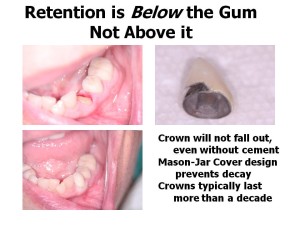It is amazing to me that everyone accepts that it is “normal” for permanent crowns to fall out and require periodic “re-cementing”. It is not normal! Crowns that can fall out can leak and decay. This can result in tooth loss. In patients who are already susceptible to decay, a tooth with a crown that repeatedly falls out will almost certainly decay.
Why do crowns fall out? The answer lies in how the crowns were made. The vast majority of dentists are taught—in every dental school–to attach their crowns to tooth structure that is above the gum. If there is not enough tooth structure above the gum, dentists will try to create tooth structure above the gum. There are several methods to do this. One is to build up the tooth with bonding or cement. However, if this does not work, dentists may perform root canal therapy on a tooth in order to make a post. A post is a metal rod that fits inside the root canal and extends above the gum. Often this approach does not work. Root canal teeth become brittle once the pulp (nerve tissue) has been removed, and they are more likely to fracture from posts as a result. What’s more, it is a sure bet that if crown and bridgework falls out, the post will come out with it.
There are several methods to do this. One is to build up the tooth with bonding or cement. However, if this does not work, dentists may perform root canal therapy on a tooth in order to make a post. A post is a metal rod that fits inside the root canal and extends above the gum. Often this approach does not work. Root canal teeth become brittle once the pulp (nerve tissue) has been removed, and they are more likely to fracture from posts as a result. What’s more, it is a sure bet that if crown and bridgework falls out, the post will come out with it.
However, there is another approach that focuses on tooth structure below the gum, rather than on tooth structure above the gum. With this approach it is not necessary to have any tooth structure above the gum! Amazingly, this approach has been around a long time and has a 70 year track record, but it does require more time and expertise. As long as there is 2 to 3 millimeters of root surface above the bone (i.e. a gingival crevice with normal anatomy), a crown can be made that does not fall out. The technique uses copper bands to register an impression of the entire root surface. This technique also ensures that the crown margins will not be visible.
The evidence is overwhelming that this approach works! At our office, all types of crowns and bridges—from single crowns to full mouth rehabilitation—were done on thousands of patients since 1950 using this approach. These crowns do not fall out, and they are always worn for a trial period with Vaseline™ or a rubber-like material. The crowns are also designed like the Mason jar cover—the best method ever devised for preserving. As a result, recurrent decay under these crowns is rare.
Because we do not need buildups or posts to restore teeth, we save a lot of teeth that many practitioners extract. We believe in saving teeth first, and that implant surgery should be a last resort. It is not normal or necessary for crowns to fall out–even if when teeth are flush with the gum.
APR
2016

About the Author:
Since graduating from Tufts University in 1977, Dr. Edward Feinberg has been on a mission to help patients and improve the profession of Dentistry. A practicing dentist in Scarsdale, New York, he is the successor to a tradition established in 1948 by his father, Dr. Elliot Feinberg--a renowned expert, teacher and author in the field of crown and bridgework, precision attachment partial dentures and implant restorations. The principles and techniques of this tradition are documented in a growing collection of more than 100,000 slides of cases that date back to 1950.